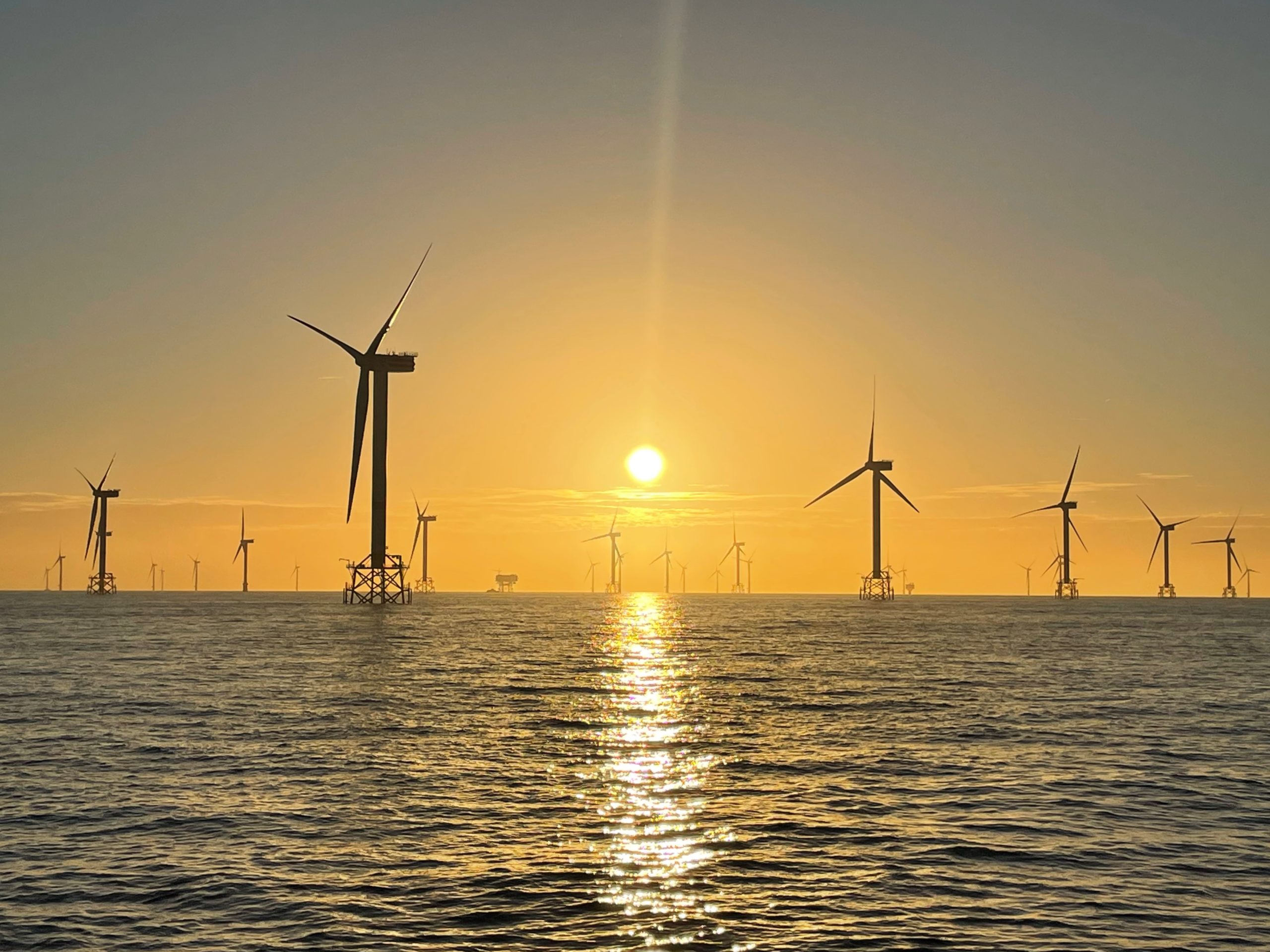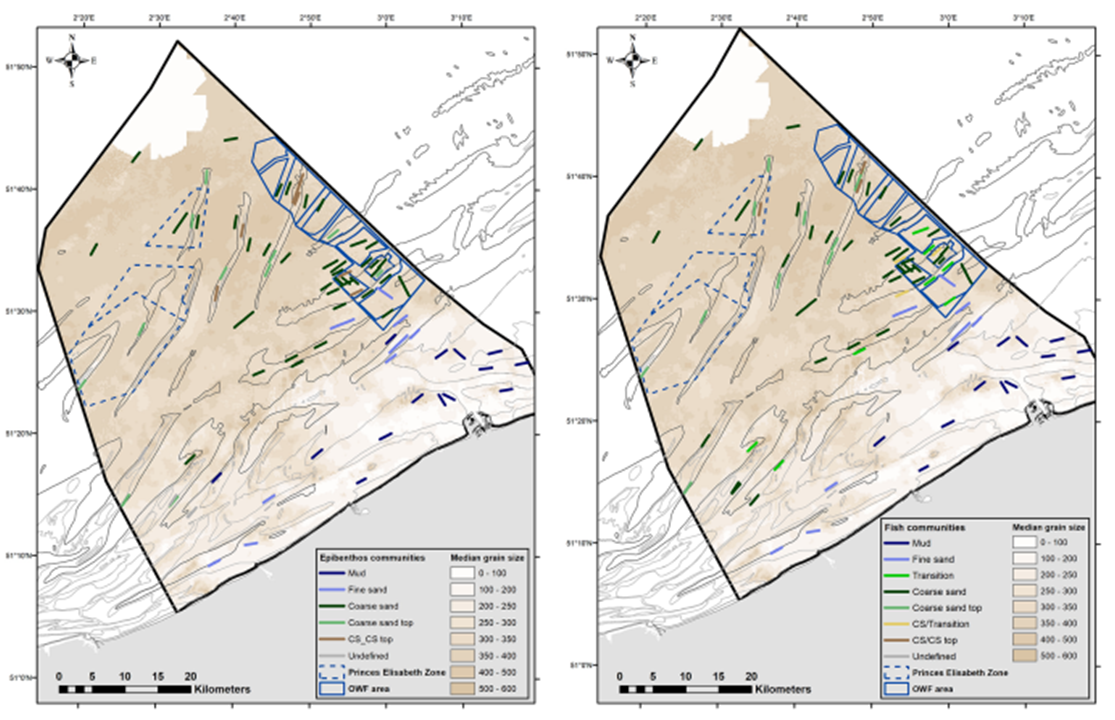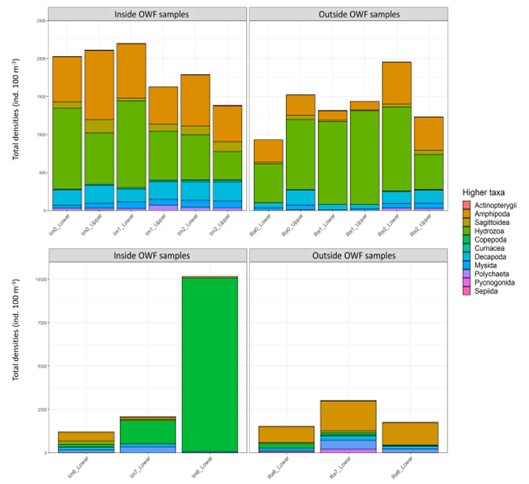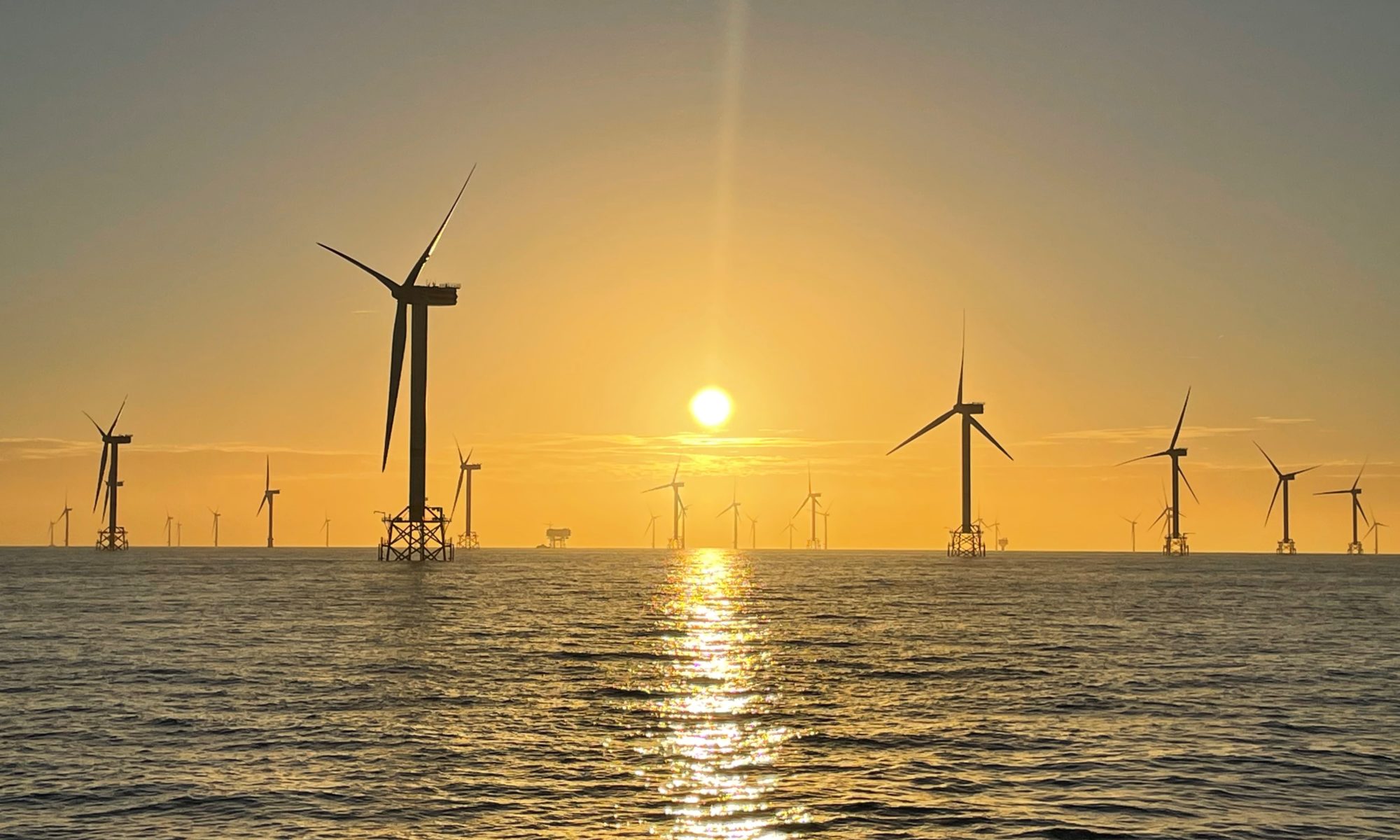In their latest annual report, the scientists that monitor the environmental impact of offshore wind farms in the Belgian part of the North Sea focus on the continued development of the programme and on the upgrade in anticipation of the wind energy capacity expansion in our waters. Notable results include that no meaningful impact of wind farms was found on the abundance of invertebrate and fish species that live on the sandy seafloor (no negative impact), that communities of organisms that live above the seafloor were enriched in wind farms (positive impact) and that species distribution models now allow to quantify the numbers of seabirds expected to be impacted by wind farm displacement (scale of impact depending on the species, with the highest sensitivity outside existing and future wind farms). Furthermore, insights around promoting the artificial reef effect and mitigating the collision risk to birds and disturbance from construction works on porpoises continue to develop.

Since the end of 2020, the number of offshore wind turbines and their combined capacity has remained unchanged in the Belgian part of the North Sea. At that time, 12 years of construction in the first Belgian marine area for renewable energy came to an end, with eight wind farms totalling 399 turbines in a zone of 238 km² along the border with the Dutch waters. Together, they account for an installed capacity of 2.26 Gigawatts (GW) and an average annual production of 8 TWh, representing around a third of the gross electricity production from renewable energy sources in Belgium.
As ‘Blue Economy’ matures to a sustainable blue economy, it has been tasked with ensuring the environmental sustainability of human activities. Therefore, the impact monitoring program WinMon.BE generates baseline ecological information in the Belgian offshore renewable energy zone since the start of the construction in 2005 at various spatial and temporal scales. Its two-fold aim is to quantify both the anticipated and unanticipated impacts and to understand the cause-effect relationships behind a selection of these ecological impacts. The knowledge gained so far has served the fine-tuning of offshore wind farm construction and operation practices, and thus helped to ensure the environmental sustainability of offshore wind energy production in the Belgian part of the North Sea. All scientific reports of the WinMon.BE monitoring are publicly available.
Preparing for an expansion
To meet the EU objective of reaching net-zero greenhouse gas emissions by 2050, our country aims to add an installed capacity of 3.15 to 3.5 GW by realising offshore wind farms in a second area for renewable energy – the Princess Elisabeth Zone (285 km²) – that is designated in the national marine spatial plan 2020-2026. It goes without saying that the knowledge gained by WinMon.BE will also serve an environment-friendly design and operation of the future offshore wind farms in the Princess Elisabeth Zone.

However, Belgium is not the only country that further develops the production of offshore wind energy in the southern North Sea. Next to the 523 km² reserved for operational and planned offshore wind farms in the Belgian part of the North Sea, 344 km² are foreseen in the adjacent Dutch Borssele zone, and 122 km² in the French Dunkerque zone. The international expansion also affects the monitoring programme.
Steven Degraer (Royal Belgian Institute of Natural Sciences/MARECO), coordinator of the WinMon.BE consortium : “As potential cumulative ecological impacts of the growing number of offshore wind farms in the southern North Sea are a major concern, detecting and understanding these becomes an important additional challenge for WinMon.BE. We also need to internationalise cooperation across the wider North Sea region, where country boundaries have tended to hamper a regional approach.”
To get ready for the monitoring of the environmental impacts of the expanding offshore wind energy sector in the Belgian part of the North Sea, the WinMon.BE 2022 report touches upon new insights into spatial distribution patterns of invertebrates and fish, the identification of areas where seabirds are most sensitive to offshore wind farms and, ‘promoting the good’ (artificial hard substrate fouling communities), and ‘mitigating the bad’ (seabird collisions and noise pollution for porpoises). The report is based on data collected up to 2021.
Spatial distribution patterns & sensitive areas
On the seafloor – epibenthos & demersal fish (ILVO)
To detect and understand potential spillover effects of the existing offshore wind farms and for the assessment of the potential impacts of the future offshore renewables zone, one must first document and understand the pre-construction situation. With respect to the distribution and abundance of epibenthos (invertebrates that live on the surface of the seabed, such as certain mollusks, crustaceans and squid species) and bottom-dwelling fish, a community analysis on abundance data was therefore conducted for the entire Belgian part of the North Sea.
It was found that both epibenthos and fish communities largely follow similar spatial distribution patterns with a clear distinction between the coastal and the offshore area. Within the coastal area, two different communities inhabit muddy and sandy sediments respectively. The offshore communities are additionally structured by sand bank topography. The existing offshore renewables zone largely overlaps with the spatial distribution of the offshore epibenthos and fish communities, for which monitoring in between the turbines did not show meaningful impacts of the wind farms.

Above the seafloor – hyperbenthos (Ghent University)
The WinMon.BE monitoring program for the first time shed a light on the hyperbenthos ecosystem component. This community consists of organisms that inhabit the water column immediately above the seafloor, including a large variety of small crustaceans and worm-like species, jellyfish-like life stages of hydrozoans, and larval life stages of larger crustaceans and fish. The impact of turbine presence (artificial reef effect) and the ceasing of fishery activities (fisheries exclusion effect) are expected to result in enriched hyperbenthic communities within the offshore wind farms. To test this, samples collected inside and outside two Belgian offshore wind farms, each with specific local habitat conditions, foundation type, construction times and at different distances to the coast, were compared.
While hyperbenthos communities at different distances to the coast appeared to differ in species composition (with more species of nearshore areas closer to the coast) and density (with higher densities closer to the coast), the densities were consistently higher in the wind farms compared to the corresponding control sites outside the wind farms. Differences in species richness (higher in the wind farm) and community structure were also observed at greater distance to the coast. These results corroborate the enrichment hypothesis. No differences in species richness and community structure were observed closer to the coast.

At the sea surface – seabirds (INBO)
For seabirds, detailed knowledge on distribution patterns is important to design adequate monitoring programs and to gain insights into area-specific sensitivity of different species to offshore wind farms. Based on seabird counts from ships, collected across the Belgian part of the North Sea in the period 2000-2018, species distribution models were created to feed into a sensitivity map regarding offshore wind farm development, and an integrated displacement sensitivity index based on their cumulative occurrence was proposed. Data were used for four seabird species known to be sensitive to wind farm-induced displacement: red-throated diver Gavia stellata, northern gannet Morus bassanus, common guillemot Uria aalge and razorbill Alca torda.
The species distribution models allow to quantify the numbers of seabirds expected to be impacted by wind farm displacement. In absolute numbers, common guillemot is the most impacted species, with about 1600 individuals being displaced by the existing and future offshore renewables zones. One area was highlighted as particularly sensitive to offshore wind farm development, situated in front of the western part of the Belgian coast between 5 and 12 nautical miles offshore. This is well outside all existing and future Belgian wind farms.

Promoting the good & mitigating the bad
‘The good’ – fouling communities (RBINS)
Previous studies have shown that foundations of offshore wind turbines are colonised by a wide array of fouling species (the artificial reef effect). Dominant species at the various stages of the colonisation process include the anemone Metridium senile, the blue mussel Mytilus edulis, and the crustacean Jassa herdmani. As a result of this colonisation the biomass on the foundation can be up to 35 times higher compared to the surrounding soft sediments. However, this higher biomass can influence local food web dynamics, and there is also concern over the establishment of non-indigenous species. To better understand the potential effects of large-scale colonisation on offshore wind turbines by fouling species, the fouling communities on the turbine foundations were compared to those on longer-existing artificial hard structures, in casu shipwrecks.
The results showed that shipwrecks had a higher species richness compared to offshore wind farms (165 vs 114 species). Furthermore, the species present on the two types of artificial hard substrates were also different, with shipwrecks holding 95 unique fouling species compared to 44 on offshore wind farms. These differences in species diversity can be attributed to the older age and the higher structural complexity of shipwrecks. By increasing the complexity of the scour protection layer surrounding turbine foundations it might be possible to increase the species richness of the fouling community. This is often considered an asset of offshore wind farms.

‘The bad’ – seabird collisions (RBINS & INBO)
Because wind turbines at sea have a relatively short life span, repowering scenarios are already being discussed for the oldest wind farms. Ongoing technological developments result in larger wind turbines and an increased open airspace between turbines. In anticipation of this, the seabird collision risk – a prominent and longstanding issue with offshore wind farms – was assessed for a hypothetical repowering scenario of the first offshore wind farm zone in Belgian waters. For all considered bird species, the estimated collision risk decreased (40% reduction on average for 15 MW turbines) because of the higher clearance between the lower tip of the rotor and the sea level, and the need for a lower number of turbines per km². Increasing the hub height of the turbines with 10 m further decreased the expected number of seabird collisions with another 37% on average.
As such, turbine size can offer an opportunity to mitigate seabird fatalities. For terrestrial birds and bats that also migrate at sea, the effect of larger turbines is less clear. It is likely that curtailment strategies, which stop the turbines during heavy migration events, will still be needed to reduce the impact on these groups.
‘The bad’ – harbour porpoise disturbance (RBINS, Ghent University & VLIZ)
A second prominent and long-standing issue with offshore wind farms is the disturbance of marine mammals during pile driving activities, producing excessive impulsive sound levels. Based on passive acoustic monitoring datasets from 2018 to 2020, including the construction periods of three offshore wind farms, it was shown that harbour porpoises Phocoena phocoena respond to pile driving over a period of hours to days. Detection rates of porpoises reduced up to 20 km from the pile driving location, with the magnitude and duration of the reduction decreasing markedly with increasing distance.
The use of sound mitigation had significant effects on the spatial and temporal extent of avoidance of the construction area by porpoises, but the reduction in porpoise detection rates appears to start even prior to the pile driving in the immediate vicinity of the construction site. This suggests that efforts to reduce the impact of underwater noise generated by future offshore wind farm construction on marine life should aim to limit not only the generated noise levels but also the overall duration of the construction.

Future research, monitoring and mitigation
Steven Degraer: “In conclusion, a continued effort to gain more knowledge is not only needed for the further follow-up of the impact of the wind farms that have already been constructed, but also for fine-tuning an environment-friendly design and operation of future offshore wind farms. Substantial progress has been made and has proved to be applicable for a sound management of offshore renewable energy. However, many unknowns remain to be tackled.”
Some examples of how these ongoing efforts will translate into practice include a continued and finer focus on the invertebrate and fish communities of the seafloor (particularly relevant in the less surveyed second offshore renewables zone), increased sampling efforts to enhance the ability to fully characterize hyperbenthos communities and strengthen the statistical power to detect offshore wind farm-related impacts, and further finetuning of the seabird modelling process, taking additional seabird species and anthropogenic pressures into account to ultimately inform the marine spatial planning process. Where necessary, mitigation measures need to continue to be designed and applied as the monitoring programme yields new insights.
The Monitoring Programme WinMon.BE is a cooperation between the Royal Belgian Institute of Natural Sciences (RBINS), the Research Institute for Nature and Forest (INBO), the Research Institute for Agriculture, Fisheries and Food (ILVO) and the Marine Biology Research Group of Ghent University, and is coordinated by the Marine Ecology and Management team (MARECO) of the Royal Belgian Institute of Natural Sciences.
WinMon.BE is commissioned by the Federal Government as part of the environmental permit conditions for offshore wind farms. For the monitoring, use was made of the research vessel Belgica (ship time on RV Belgica was made available by BELSPO and RBINS – OD Nature), the research vessel Simon Stevin (operated by the Flanders Marine Institute), several private vessels, the Belgian scientific diving team and the observation aircraft of RBINS.

